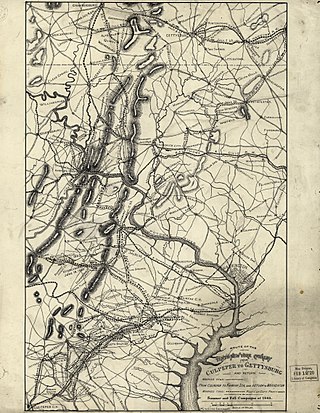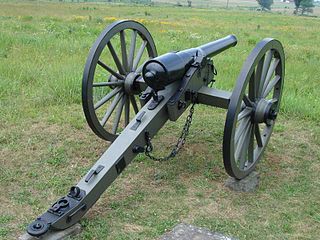The 5th Wisconsin Infantry Regiment was an infantry regiment that served in the Union Army during the American Civil War.

The 121st New York Infantry Regiment, commonly known as the "Onesers" or "Upton's Regulars", was a volunteer regiment recruited during the American Civil War from Otsego County and Herkimer County, New York. The Hon. Richard Franchot was appointed colonel of the regiment and authorized to establish his headquarters at Richfield Springs, Otsego County. He proceeded without delay to organize the regiment, and on August 23, 1862, the regiment was mustered into the service of the Union Army. The command at that time consisted of 39 officers and 946 enlisted men. The 121st Regiment proceeded to Washington, arriving there on the morning of September 3, and was assigned provisionally to a brigade under Colonel Gibson with headquarters at Fort Lincoln.

The 14th New Jersey Infantry Regiment was an infantry regiment in the Union Army during the American Civil War. Their most notable engagement was the Battle of Monocacy, where the unit sustained heavy casualties halting a Confederate advance. Fourteen months earlier, the regiment spent their first encampment of the war guarding Monocacy Junction. The regiment was given the title of "The Monocacy Regiment".

The 106th New York Infantry Regiment was an infantry regiment in the Union Army during the American Civil War.

The 110th Ohio Volunteer Infantry was an infantry regiment in the Union Army during the American Civil War.

The 151st New York Infantry Regiment was an infantry regiment in the Union Army during the American Civil War.
The 87th Pennsylvania Volunteer Infantry was an infantry regiment that served in the Union Army during the American Civil War.

The 138th Regiment, Pennsylvania Volunteer Infantry was an infantry regiment that served in the Union Army during the American Civil War.
The 2nd Ohio Cavalry Regiment was a cavalry regiment that served in the Union Army during the American Civil War.
The 1st New Hampshire Cavalry Regiment was a cavalry regiment that served in the Union Army during the American Civil War.
The 1st Connecticut Cavalry Regiment was a cavalry regiment that served in the Union Army during the American Civil War.

The 10th New York Cavalry Regiment was a cavalry regiment that served in the Union Army during the American Civil War.
The 1st Pennsylvania Cavalry was a cavalry regiment that served in the Union Army as part of the Pennsylvania Reserves infantry division during the American Civil War.
The 2nd New Jersey Infantry Regiment was an infantry regiment in the Union Army during the American Civil War.

The 77th New York Infantry Regiment was an infantry regiment in the Union Army during the American Civil War.
Battery "C" 4th Regiment of Artillery was a light artillery battery that served in the Union Army during the American Civil War.
The 82nd Pennsylvania Volunteer Infantry was an infantry regiment that served in the Union Army during the American Civil War. It was designated the 31st Pennsylvania Volunteer Infantry until after the Battle of Seven Pines but changed to avoid confusion with the 2nd Pennsylvania Reserve Regiment, which was renumbered.

The 17th Pennsylvania Cavalry Regiment was a cavalry regiment in the Union Army during the American Civil War. It was the second regiment formed in response to President Abraham Lincoln's call July 2, 1862 requesting Pennsylvania furnish three cavalry regiments.

The 4th U.S. Artillery, Battery E was an artillery battery that served in the Union Army during the American Civil War. The unit fought at the battles of Kernstown, Port Republic, Rappahannock Station, Second Bull Run, Chantilly, Antietam, and Fredericksburg in 1862. The battery transferred to the Cavalry Corps where it served for the rest of the war. In 1863, 4th U.S. Artillery, Battery E fought at Chancellorsville, Gettysburg, Culpeper, Bristoe Station, and Mine Run. In 1864, the unit fought at the Wilderness, Todd's Tavern, Yellow Tavern, Totopotomoy, Cold Harbor, the Wilson-Kautz Raid, Opequon, Fisher's Hill, and Cedar Creek. In 1865, it saw action at Dinwiddie Court House, Five Forks, Sailor's Creek, and Appomattox before taking part in the Grand Review of the Armies.

The 6th New York Cavalry Regiment, also known as the 6th Regiment New York Volunteer Cavalry and nicknamed the "2nd Ira Harris Guards", was a cavalry regiment of the Union Army during the American Civil War. The majority of its fighting was in Virginia as part of the Army of the Potomac.







